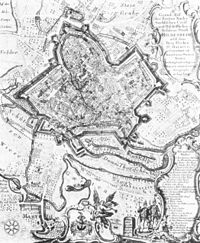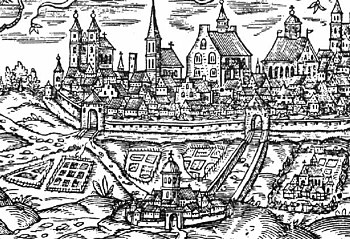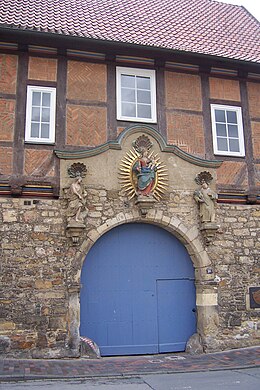Hildesheim Charterhouse
| Hildesheim around 1750 | |||
|---|---|---|---|
| The old Charterhouse (1388–1632) |
The new Charterhouse (1659–1777) |
||
The Hildesheim Charterhouse is a former Carthusian monastery in Hildesheim in the Hildesheim diocese .
history
The Charterhouse " Domus Claustri Beatae Mariae " was founded by Bishop Gerhard (Bishop from 1365 to 1398) as thanks for the victory over Duke Magnus I of Braunschweig-Wolfenbüttel in the Battle of Dinklar . The deed of foundation was issued on May 2, 1388. The first monks came from the Carthusian monastery in Erfurt . The monastery complex was initially built outside the city of Hildesheim, in front of the "Dammtor" (a gate to the dam city ), in the west of the city, on the property of the patrician family "von Rössing ". It was not until 1448 that the Charterhouse became the full owner of the developed land.
On June 20, 1522 the Charterhouse was set on fire by residents of the city of Hildesheim during the collegiate feud . In 1542, the city council decided to introduce the Reformation in Hildesheim and after the monastery was plundered several times in 1542 and 1543, the monks under their prior Dietrich Loher (around 1495–1554) initially withdrew to Cologne. When Loher became prior of the Buxheim Charterhouse near Memmingen in 1543 , several brothers followed him to Upper Swabia .
|
|
|
|---|---|
| The old Charterhouse (1388–1632) in 1586, bottom right in the picture. |
On July 30, 1545, the monastery was sacked again. The city council took over the monastery treasure and the documents. Parts of the building were used as city fortifications. It was not until 1613 that the Carthusians were able to repopulate the monastery. On July 23, 1626, during the Thirty Years War , Danish troops and residents of Hildesheim destroyed the Charterhouse. The buildings were completely demolished in 1632.
Under Prince-Bishop Maximilian Heinrich , the monastery was relocated to buildings within the city walls between 1659 and 1660 for better protection, between the cathedral courtyard and the Langelinienwall.
In 1708, Bernhard Aly , a so-called " booty Turk ", entered the monastery. Aly, who was named Weißenburg after his baptism, after the German name of his hometown Belgrade , was still in the Charterhouse in 1758 under the religious name of Pater Josephus .
In 1777 the monastery was closed after the Hildesheim prince-bishop Friedrich Wilhelm von Westphalen , in agreement with Pope Pius VI. and Emperor Joseph II , the property and the property of the Charterhouse had intended to improve the income of the seminary . The monks were transferred to Carthusian monasteries abroad. The last prior of the monastery, Carl Unkraut (1731–1823), went to the Vogelsang Charterhouse near Jülich , where he became prior in 1796 and stayed there until it was dissolved in 1802.
The cathedral library received part of the monastery library . The buildings were initially used as a seminary, later as a poor institution and school for the poor . On June 11, 1852, the Hildesheim Bishop Eduard Jakob Wedekin founded the St. Bernward Hospital , which still exists today, in the so-called "Karthaus", the south wing of the secularized Charterhouse .
Buildings
The baroque portal of the Carthusian monastery on Neue Straße is the final, visible evidence of the Carthusian monastery. The Radiant Madonna , John the Baptist and Saint Bruno of Cologne , founder of the Carthusian Order, stand on the pedestals above the portal of the "Karthaus". The building is now used by the St. Bernward Hospital.
literature
- Friedrich Eymelt: On the history of the Hildesheim Charterhouse . In: The Diocese of Hildesheim in the past and present - Yearbook of the Association for Local Studies in the Diocese of Hildesheim , Volume 55 (1987), pp. 79–88.
- Harald Goder: The abolition of the Hildesheim Charterhouse in 1777 . In: The Carthusians in the 17th and 18th Centuries - Files of the VIII. International Congress for Carthusian Research , Ittingen 1988, pp. 185–211.
- Harald Goder: Hildesheim , in: Monasticon Cartusiense , ed. by Gerhard Schlegel, James Hogg, Volume 2, Salzburg 2004, 740–747.
- Sönke Lorenz (Ed.): Books, libraries and written culture of the Carthusian monks - Festgabe for the 65th birthday of Edward Potkowski , Franz Steiner Verlag, Stuttgart 2002, ISBN 3-515-08093-7 .
- Gerhard Schlegel: Notes on the history of the Hildesheim Charterhouse . In: The Diocese of Hildesheim in the past and present - Yearbook of the Association for Local Studies in the Diocese of Hildesheim , Volume 56 (1988), pp. 7-17.
Web links
Individual evidence
- ↑ Sönke Lorenz, Oliver Auge, Robert Zagolla: Books, Libraries and Writing Culture of the Carthusians - Festgabe for the 65th birthday of Edward Potkowski , Franz Steiner Verlag, Stuttgart 2002, p. 139.
- ^ Edmund Koken, Hermann Adolf Lüntzel : Mittheilungen historical and non-profit content - magazine for the Principality of Hildesheim and the city of Goslar , Gerstenberg publishing house, Hildesheim 1832, pp. 263-267.
- ↑ Muhammad Salim Abdullah : History of Islam in Germany . Verlag Styria, Graz-Vienna-Cologne 1981, p. 19, ISBN 3-222-11352-1 .
- ↑ Martin Homza: Central European Carthusians in the family of the Carthusian Order , publishing house Institute for English and American Studies at the University of Salzburg, Salzburg 2008, p. 34.
- ^ Willi Baumann (Ed.): The Catholic Clergy in Oldenburger Land , Dialogverlag, Münster 2006, pp. 536-538.
- ^ Architects' Association of Berlin (ed.): Deutsche Bauzeitung , Volume 20, Berlin 1886, p. 120.
Coordinates: 52 ° 8 ′ 49.5 ″ N , 9 ° 56 ′ 53.9 ″ E



